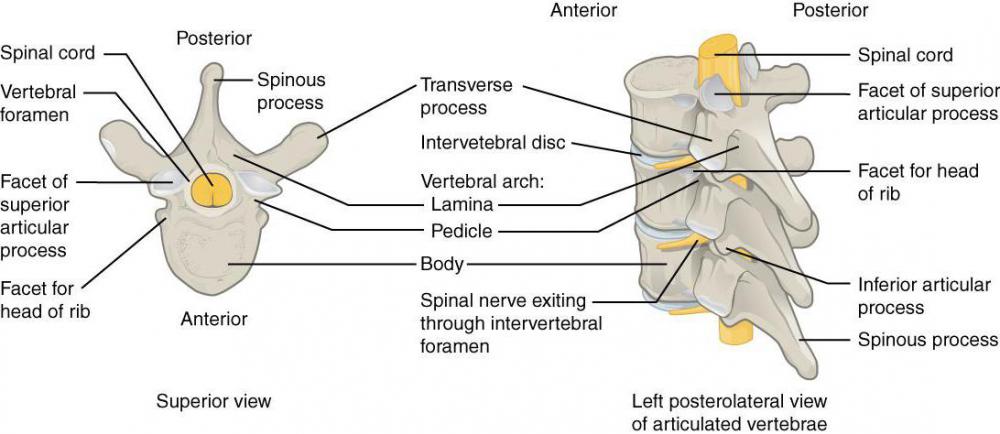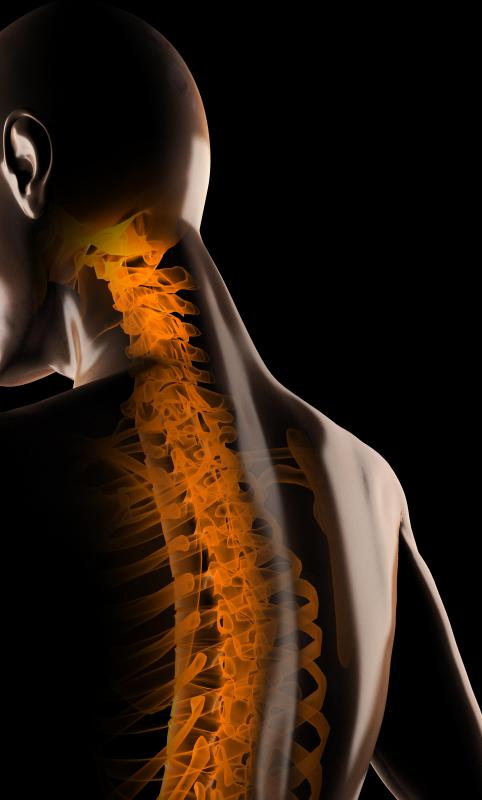At TheHealthBoard, we're committed to delivering accurate, trustworthy information. Our expert-authored content is rigorously fact-checked and sourced from credible authorities. Discover how we uphold the highest standards in providing you with reliable knowledge.
In Anatomy, What Is the Pedicle?
In anatomy, the pedicle is a short protrusion on the inner part of each vertebra in the spine of all humans and many animals. From a distance, the spine often looks like a solid column but in fact it is made of individual vertebrae, which are ring-shaped bones that together form something of a hollow tube through which many of the body’s most important nerves pass and, critically, connect to the brain. Vertebrae normally take on a slightly oval shape, and each typically contains two “wings,” sometimes also thought of as feet, that protrude from each side. Each of these feet is known anatomically as a pedicle and helps secure each bone into the next, which is thought to strengthen the larger column in much the way that interlocking logs or bricks strengthen the walls of structures. The protrusions are generally strong, but they can snap or crack under pressure, and fragments that are lost or broken can pinch nerves and cause a lot of pain and other problems. Pedicles are sometimes also the site of growths and mineral buildups on the bone, which can lead to similar issues and often require surgery to remedy.
Understanding Human Vertebrae Generally

The spine is one of the human body’s most complex structures, and in addition to nerve protection it also serves a number of physiological functions, including flexibility of movement and providing the necessary structural support for upright posture. The spine is comprised of 33 vertebrae, and each is stacked on the next to create a kind of column. There are four distinct regions of the spine, identified as the cervical, thoracic, lumbar, and sacral region. Vertebrae come in various sizes depending on their location as well as their overall age and development, but in all cases they have the same basic components. The simplest way to think about vertebra composition is usually in reference to the ring’s anterior or posterior arch.
Locating Pedicle Pairs

For humans and the majority of all spined animals, each vertebra is comprised of two bone arches, called the anterior and posterior arches. These form an opening that the body’s primary nerve cord passes through. Pedicles are found on either side of the posterior arch, with the shapes directed slightly upward and to the back.
The anterior arch, also referred to as the vertebral body, is connected to each successive bone ring in the column with discs that help with the flexibility of the spine as a whole. Vertebral bodies and discs support the majority of the weight of the spine. Above and below each pedicle pair is a concave shape known as the vertebral notch, which, together with each successive vertebra, forms what’s known as the intervertebral foramina. Extending off the laminae, or the boney walls of the posterior arch, are a variety of processes that connect the spine to ligaments and tendons.
Role in Nerve Coordination and Passage

Perhaps the spine’s most important function is to protect the spinal cord. It is essentially the main neural pathway that transmits information throughout the body. The anterior and posterior arches form an open area in the center of the vertebra called the foramen. It is through these foramina that the spinal cord passes, with nerve roots exiting to the body between the pedicles.
Likelihood of Injury and Related Problems
The pedicles are not immune to injury, and these protrusions can cause significant pain and nerve problems should they become misaligned or otherwise twisted or damaged. In the case of spine instability, it is possible for the pedicles to press down on a nerve root, resulting in pain or numbness. A number of growths, including cysts and tumors, can attach more readily to the feet than to the core of the vertebral ring itself. Growths can be difficult to detect and often require surgery to diagnose and remove.
AS FEATURED ON:
AS FEATURED ON:













Discuss this Article
Post your comments